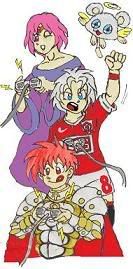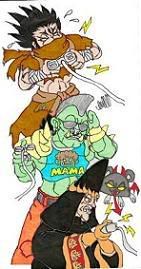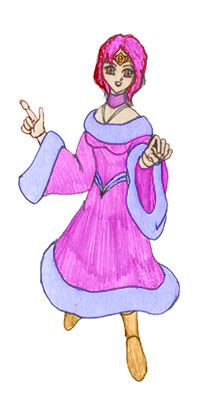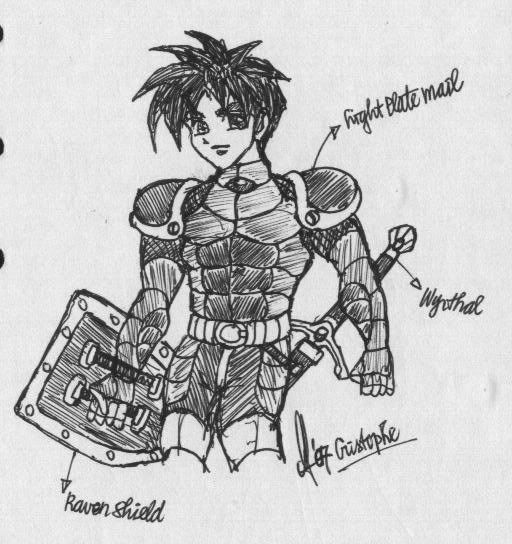Longsword
From Wikipedia, the free encyclopedia
(Redirected from
Bastard sword)
Jump to:
navigation,
searchFor other uses, see
Longsword (disambiguation).
Longsword
Swiss longsword, 15th or early 16th century (
Morges museum)
Type
SwordService history
In service
ca. 1250 - 1550
Specifications
Weight
avg. 3 lbs. (1.45 kg)
Length
avg. 48" (120 cm)
Blade length
avg. 37" (92.5 cm)
Blade type
Double-edged, straight bladed
Hilt type
Two-handed cruciform, with pommel
The Longsword is a type of European
sword used during the
late medieval and
Renaissance periods, approximately 1250 to 1550. Longswords have lengthy
cruciform hilts with grips over six inches (15 cm) in length, straight double-edged blades often over thirty-five inches (89 cm) in length, and weigh between 2 (0.9 kg) and 4.5 pounds (2 kg).
[1]The longsword is commonly held in combat with both hands, though it may be used single-handed. Longswords are used for striking, cutting, and thrusting. The specific offensive purpose of an individual longsword is derived from its physical shape. All parts of the sword are used for offensive purposes, including the pommel and crossguard.
Contemporary terminology includes the
Dutch grootzwaard,
German Langschwert,
Italian spadone or spada longa (lunga) and
Portuguese montante. The French espée bastarde references the bastard sword, a type of longsword. The terms "hand-and-a-half sword", "
greatsword", and "bastard sword" are used colloquially to refer to longswords in general.
Contents[
hide]
1 History1.1 Bastard swords2 Form3 Combat3.1 Bloßfechten3.2 Harnischfechten4 References5 See also6 Further reading7 External links//
[
edit] History
The evolution of the sword before and after the development of the longsword was not entirely linear. Swords of an older type may have coexisted with newer variants for quite some time, making it difficult to trace a single path of sword evolution. Instead, the course of sword development is layered with some swords evolving from a previous type of sword, acting as its able contemporary, and eventually being abandoned while the original design continued in use for some time afterward. Similarly, variants of a particular type of sword may have come about not to replace it, but to simply coexist with it until a new evolution brought a close to both older types of weapons. Such situations present both the path of sword development as a whole and the encompassed rise and fall of the longsword as chronologically nebulous and confused by broad definitions, both modern and contemporary.
The relatively comprehensive
Oakeshott typology was created by historian and illustrator
Ewart Oakeshott as a way to define and catalogue swords based on physical form, though a rough sense of chronology is apparent. This typology does not set forth a prototypical definition for the longsword, however. Instead, it separates the broad field of weaponry into many exclusive types based on their predominant physical characteristics including
blade shape and
hilt configuration. The typology also focuses on the smaller, and in some cases contemporary
[2], single-handed swords like the
arming sword.
The longsword, with its longer grip and blade, appears to have become popular during the 14th century and remained in common use, as shown through period art and tale, from 1250 to 1550.
[3] The longsword was a powerful and versatile weapon, but was not considered the only weapon needed for learning the arts of war.
Sigmund Ringeck, an influential
Fechtbuch (combat manual) author, writes that young knights should learn to "wrestle well, (and) skilfully wield spear, sword, and dagger in a manly way."
[4] It is apparent that even to a master swordsman, other weapons and techniques are of great importance for battle. For close personal infantry combat, however, the longsword was prized for its versatility and killing capability.
[5]It is in the Types XIIa and XIIIa that the first early variants of the longsword arise as simply longer versions of the single-handed sword. There are rare archeological findings of swords of this type from as early as the late 12th century.
[6] Boasting both increased grip length and increased blade lengths, these weapons would have been powerful hewing swords, perhaps developed to further combat the prevalence of
mail[7] and
plate armour. These weapons also firmly fit the modern colloquial term "hand-and-a-half sword", as Oakeshott notes, because they do not provide a full two-hand grip as do some early extant specimens and the 16th century bidenhänder.
[
edit] Bastard swords
The bastard sword, or contemporary espée bastarde, is a type of sword dating from roughly the early 15th century. It received its name for fitting into neither the one-handed sword family, nor the "two handed sword family", thus being labelled a "bastard."
[citation needed] These weapons featured longer grips similar to those found on the longswords. The extra space was not enough to allow both hands entirely, however, but was enough to provide for the use of a couple of fingers or a part of the palm, providing some extra leverage.
[8] The grips of bastard swords often feature a "waisted" appearance, as in the Oakeshott Type XVIa.
[9] The bastard sword, more so than the great sword, plays into the "hand-and-a-half sword" classification, as some great swords provided considerably more than an extra "half" hand for gripping. Similarly, the shorter length of the weapon at roughly 45 to 55 inches (115-140cm) put the sword halfway between the shorter single-handed sword and the larger (and occasionally fully two-handed) great sword.
[10]Like all other types of swords, the bastard sword existed in a number of configurations, generally tending towards a strongly tapered and thicker blade as time went on. This manifestation, along with a relatively small blade length in relation to hilt length, gave the sword a very precise and reactive nature that served well for cutting or thrusting, much like a
side-sword.
[9] The form of the bastard sword began very much like that of the greatsword, based in the beginning of the 15th century off transition swords evolving from the
spatha. Like the transition swords, the first bastard swords featured a plain or cruciform cross and a round or wheel pommel.
[8] Later development of the weapon, however, saw the inclusion of curved quillions, ring guards, and compound hilts similar to those on baskethilts (swords like the
schiavona that nearly enclosed the entire hand in a protective guard).
[10] These served to provide increased protection for the wielders hands and may have also positively affected the balance of the weapon.
Such swords with compound hilts include the German Reitschwert, a form of cavalry sword, and the "Degen" or "Knight's Sword". It is possible, however, that these swords are in fact a single-handed manifestation of the
estoc.
[9][
edit] Form
A basic anatomy of the Renaissance longsword.
While nearly every longsword is in some way different from another, most contain a few essential parts. The blade of the sword forms the cutting portion of the weapon and is usually double-edged. Blades came in a variety of shapes and sizes. Broad and thin blades are more effective for cutting-oriented longswords while thick tapering blades are found on varieties more effective at thrusting. However, all longswords were effective at cutting, slicing and thrusting and variations in form made only minor alterations in use. The hilt comprises the portion of the sword that is not the blade - essentially everything else. Like the blade, hilts evolved and changed over time in response to fashion and as the swords were designed for different specific purposes.
Different blade cross-sections. At the top, variants of the diamond shape. At the bottom, variants of the lenticular shape.
The blade of the medieval longsword is straight and predominantly double edged. The construction of the blade is relatively thin, with strength provided by careful blade geometry. Over time, as is evidenced in the Oakeshott typology and other similar systems, the blades of longswords become slightly longer, thicker in cross-section, less wide, and considerably more pointed. This design change is largely attributed to the use of plate armour as an effective defense, more or less nullifying the ability of a sword cut to break through the armour system. Instead of cutting, long swords were then used more to thrust against opponents in plate armour, requiring a more acute point and a more rigid blade. However, the cutting capability of the longsword was never entirely removed, as in some later rapiers, but was supplanted in importance by thrusting capability.
Blades differ considerably in cross-section, as well as in length and width. The two most basic forms of blade cross-section are the lenticular and diamond. Lenticular blades are shaped like thin doubly convex
lenses, providing adequate thickness for strength in the center of the weapon while maintaining a thin enough edge geometry to allow a proper cutting edge to be ground. The diamond shaped blade slopes directly up from the edges, without the curved elements of the lenticular blade. The central ridge produced by this angular geometry is known as a riser, the thickest portion of the blade that provides ample rigidity. These basic designs are supplemented by additional forging techniques that incorporated slightly different variations of these cross-sections.
The most common among these variations is the use of fullers and hollow-ground blades. While both of these elements concern themselves with the removal of material from the blade, they differ primarily in location and final result. Fullers are grooves or channels that are removed from the blade, in longswords, usually running along the center of the blade and originating at or slightly before the hilt. The removal of this material allows the smith to significantly lighten the weapon without compromising the strength to the same extent, much as in the engineering of steel
I-beams. Though colloquially called "blood-grooves", fullers were not designed, nor do they function, to allow blood to flow out of a wound more easily, nor to run off the sword. Fullers differ in number and thickness on swords, with some incredibly broad fullers spanning nearly the entire width of the weapon while smaller more numerous fullers are usually thinner. The length of fullers also displays variation - on some cutting blades the fuller may run nearly the entire length of the weapon, while the fuller stops one-third or half-way down other blades. Hollow-ground blades have concave portions of steel removed from each side of the riser, thinning the edge geometry while keeping a thickened area at the center to provide strength for the blade.
A variety of hilt styles exist for longswords, with the style of pommel and crossguard changing over time to accommodate different blade properties and to fit emerging stylistic trends.
[
edit] Combat
1440s illustration of one- and two-handed use of the longsword. Note the sword being used one-handed is drawn shorter and may also be intended as a large
knightly sword (
CPG 339 fol. 135r).
Example of two handed use vs. half-sword, dating to ca.
1418 (
CPG 359, fol. 46v).
Half-swording in plate armour. On the right, a
mordhau. (Codex Wallerstein, plate 214.)
For more details on this topic, see
Historical fencing.
Combat with the longsword was not so barbaric and crude as is often portrayed. Codified systems of fighting existed, with a variety of styles and teachers each providing a slightly different take on the art. The longsword was a quick, effective, and versatile weapon capable of deadly thrusts, slices, and cuts.
[11] The blade was generally used with both hands on the hilt, one resting close to or on the pommel. However, in some circumstances, the weapon may be used only with one hand. In a depiction of a duel, individuals may be seen wielding sharply pointed longswords in one hand, leaving the other hand open to manipulate the large dueling shield.
[12] Another variation of use comes from the use of armour.
Half-swording was a manner of using both hands, one on the hilt and one on the blade, to better control the weapon in thrusts and jabs. This versatility was unique, as multiple works hold that the longsword provided the foundations for learning a variety of other weapons including spears, staves, and polearms.
[11] [13] Use of the longsword in attack was not limited only to use of the blade, however, as several fechtbücher explain and depict use of the pommel and cross as offensive weapons.
[14] The cross has been shown to be used as a hook for tripping or knocking an opponent off balance.
[11]What is known of combat with the longsword comes from artistic depictions of battle from manuscripts and the fechtbuch of Medieval and Renaissance Masters. Therein the basics of combat were described and, in some cases, depicted. The
German school of swordsmanship includes the earliest known longsword fechtbuch, a manual from approximately 1389 accredited to
Johannes Liechtenauer.
[15] This manual, unfortunately for modern scholars, was written in obscure verse. It was through students of Liechtenauer, like
Sigmund Ringeck, who transcribed the work into more understandable prose
[16] that the system became notably more codified and understandable.
[17] Others provided similar work, some with a wide array of images to accompany the text.
[18]The
Italian school of swordsmanship was the other primary school of longsword use. The 1410 manuscript by
Fiore dei Liberi presents a variety of uses for the longsword. Like the German manuals, the weapon is most commonly depicted and taught with both hands on the hilt. However, a section on one-handed use is among the volume and demonstrates the techniques and advantages, such as sudden additional reach, of single-handed longsword play.
[19] The manual also presents half-sword techniques as an integral part of armoured combat.
Both schools declined in the late 16th century, with the later Italian masters forgoing the longsword and focusing primarily on
rapier fencing. The last known German manual to include longsword teaching was that of
Jakob Sutor, published in
1612. In Italy, spadone, or longsword, instruction lingered on in spite of the popularity of the rapier, at least into the mid-17th century (Alfieri's Lo Spadone of
1653), with a late treatise of the "two handed sword" by one
Giuseppe Colombani, a dentist in
Venice dating to
1711. A tradition of teaching based on this may have survived into 19th and 20th century Italy
stick fighting, e.g. with Giuseppe Cerri's Trattato teorico e pratico della scherma di bastone of
1854. However, there can be no doubt that the heyday of the longsword on the battlefield was over by 1500.
[
edit] Bloßfechten
Bloßfechten or "bare fighting" is the technique of fighting without significant protective armour such as
plate armour,
mail or
brigandine.
[20] Vulnerable targets like the head and upper torso are totally unprotected except for normal clothing during Bloßfechten. The lack of significant torso and limb protection leads to the use of a large amount of cutting and slicing techniques in addition to thrusts. These techniques could be nearly instantly fatal or incapacitating, as a thrust to the skull, heart, or major blood vessel would cause massive trauma. Similarly, strong strikes could cut through skin and bone, effectively amputating limbs. The hands and forearms are a frequent target of some cuts and slices in a defensive or offensive maneuver, serving both to disable an opponent and align the swordsman and his weapon for the next attack.
[
edit] Harnischfechten
Harnischfechten, or "armoured fighting", depicts fighting in protective gear, most specifically plate armour.
[20] The increased defensive capability of a man clad in "full harnisse" (a full suit of plate armour) caused the use of the sword to be drastically changed. While slashing attacks were still moderately effective against infantry wearing half-plate armor, cutting and slicing attacks against an opponent wearing plate armour were almost entirely ineffective in providing any sort of slashing wound as the sword simply could not cut through the steel.
[21] Instead, the energy of the cut becomes essentially pure
concussive energy. The later hardened plate armours, complete with ridges and roping, actually posed quite a threat against the careless attacker. It is considered possible for strong blows of the sword against plate armour to actually damage the blade of the sword, potentially rendering it much less effective at cutting and producing only concussive effect against the armoured opponent.
To overcome this problem, swords began to be used primarily for thrusting. The weapon was used in the
half-sword, with one or both hands on the blade. This increased the accuracy and strength of thrusts and provided more leverage for Ringen am schwert or "Wrestling at/with the sword". This technique combines the use of the sword with wrestling, providing opportunities to trip, disarm, break, or throw an opponent and place them in a less offensively and defensively capable position. During half-swording, the entirety of the sword works as a weapon, including the pommel and crossguard which function as a mace as shown in the
mordhau.
[21][
edit] References
^ Clements, John.
What did historical swords weigh?^ Oakeshott, Ewart. The Sword in the Age of Chivalry. Boydell Press 1994. Page 18-19.
^ Oakeshott, Ewart. The Sword in the Age of Chivalry. Boydell Press 1994. Page 56.
^ Lindholm, D. & Svard, P. Sigmund Ringneck's Knightly Art of the Longsword Paladin Press, 2003. Page 17.
^ Clements, John.
Myths of Renaissance Martial Arts^ Sotheby's: Antique Arms, Armour, and Militaria 26 June 2003. Item 31. "A fine Medieval 'Great' sword second half of the 12th/first half of the 13th century."
^ Oakeshott, Ewart. The Sword in the Age of Chivalry. Boydell Press 1994. Page 40.
^
a b Stone, G. C. A Glossary of the Construction, Decoration, and Use of Arms and Armour. Jack Brussel, 1961. Page 280.
^
a b c Clements, John.
Sword Forms^
a b Tarassuk, Leonid & Blair, Claude. The Complete Encyclopedia of Arms & Weapons. Simon and Schuster, 1982. Page 80.
^
a b c Rector, Mark. Medieval Combat: A Fifteenth-Century Illustrated Manual of Swordfighting and Close-Quarter Combat. Green Hill Books, 2000. Page 15-16.
^ Rector, Mark. Medieval Combat: A Fifteenth-Century Illustrated Manual of Swordfighting and Close-Quarter Combat. Green Hill Books, 2000. Plate 128-150.
^ Lindholm, David. Fighting with the Quarterstaff: A Modern Study of Renaissance Technique. Chivalry Bookshelf, 2006. Page 32.
^ Rector, Mark. Medieval Combat: A Fifteenth-Century Illustrated Manual of Swordfighting and Close-Quarter Combat. Green Hill Books, 2000. Plate 67, 73 - 74.
^ Liechtenauer, Johannes. MS
3227a^ Ringeck, Sigmund. MS Dresd. C 487
^ Lindholm, D. & Svard, P. Sigmund Ringneck's Knightly Art of the Longsword Paladin Press, 2003. Page 11.
^ Talhoffer, Hans. Thott 290 2
^ dei Liberi, Fiore. Flos Duellatorum.
^
a b Clements, John.
Medieval and Renaissance Fencing Terminology^
a b Lindholm, David & Svärd, Peter. Signmund Ringeck's Knightly Arts of Combat. Paladin Press, 2006. Page 219.
[
edit] See also
Historical European Martial ArtsOakeshott typologyRicassoSide-swordClaymoreWasterJian[
edit] Further reading
David Lindholm & Peter Svärd, Sigmund Ringeck's Knightly Art of the Longsword, Paladin Press (2003),
ISBN 1-58160-410-6Christian Henry Tobler, Secrets of German Medieval Swordsmanship (2001),
ISBN 1-891448-07-2Christian Henry Tobler, Fighting with the German Longsword (2004),
ISBN 1-891448-24-2Guy Windsor, The Swordsman's Companion: A Modern Training Manual for Medieval Longsword (2004),
ISBN 1-891448-41-2John Clements, Medieval Swordsmanship: Illustrated Methods and Techniques. Paladin Press, 1998.
ISBN 1-58160-004-6Grzegorz Zabinski & Bartlomiej Walczak. The Codex Wallerstein : A Medieval Fighting Book from the Fifteenth Century on the Longsword, Falchion, Dagger, and Wrestling. Paladin Press, 2002.
ISBN 1-58160-339-8[
edit] External links
AEMMA - Academy of European Medieval Martial ArtsARMA - The
Association for Renaissance Martial ArtsBritish Federation for Historical SwordplayChicago Swordplay GuildHEMAC - Historical European Martial Arts CoalitionLes Maîtres D'Armes - School of ArmizareMid-Atlantic Society for Historic SwordsmanshipMedieval European Martial Arts GuildMyArmoury - Call to Arms: The German LongswordSchola GladiatoriaSchola Saint GeorgeTattershall School of DefenceRetrieved from "
http://en.wikipedia.org/wiki/Longsword#Bastard_swords"






 Morning star (weapon)
Morning star (weapon)

 Adler also points his Kraal’shazar straight to Robert’s neck. The two champions are at a brink of a fight, but before Adler unleashes his first move, Fingers of the Blade, Pope Xylen shouts,
Adler also points his Kraal’shazar straight to Robert’s neck. The two champions are at a brink of a fight, but before Adler unleashes his first move, Fingers of the Blade, Pope Xylen shouts,